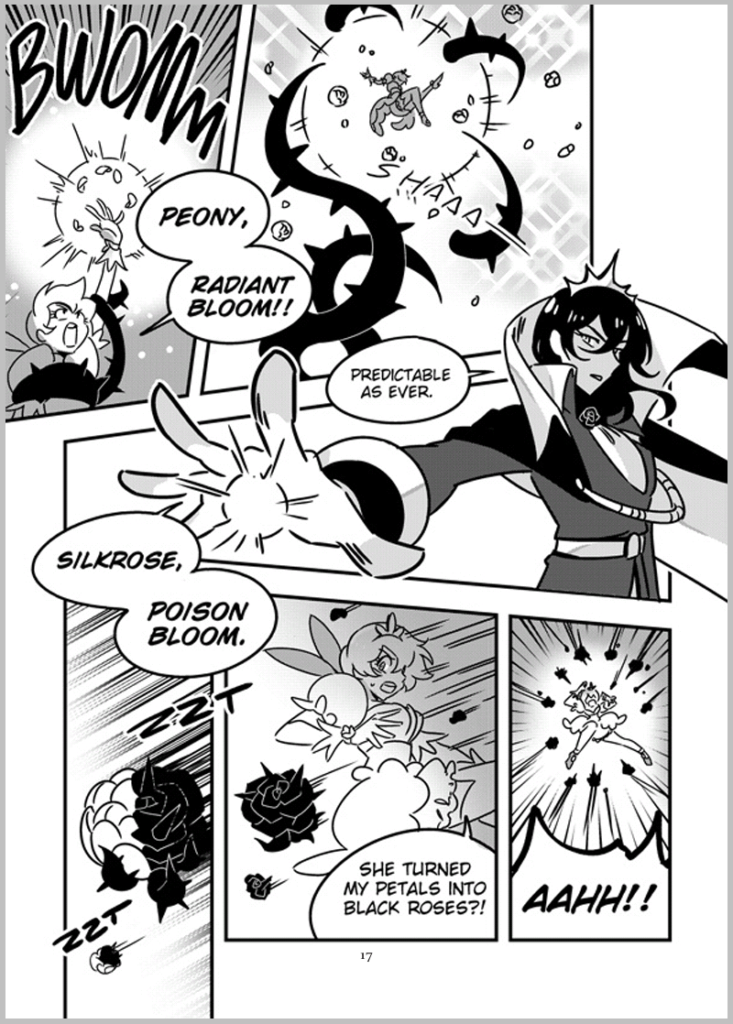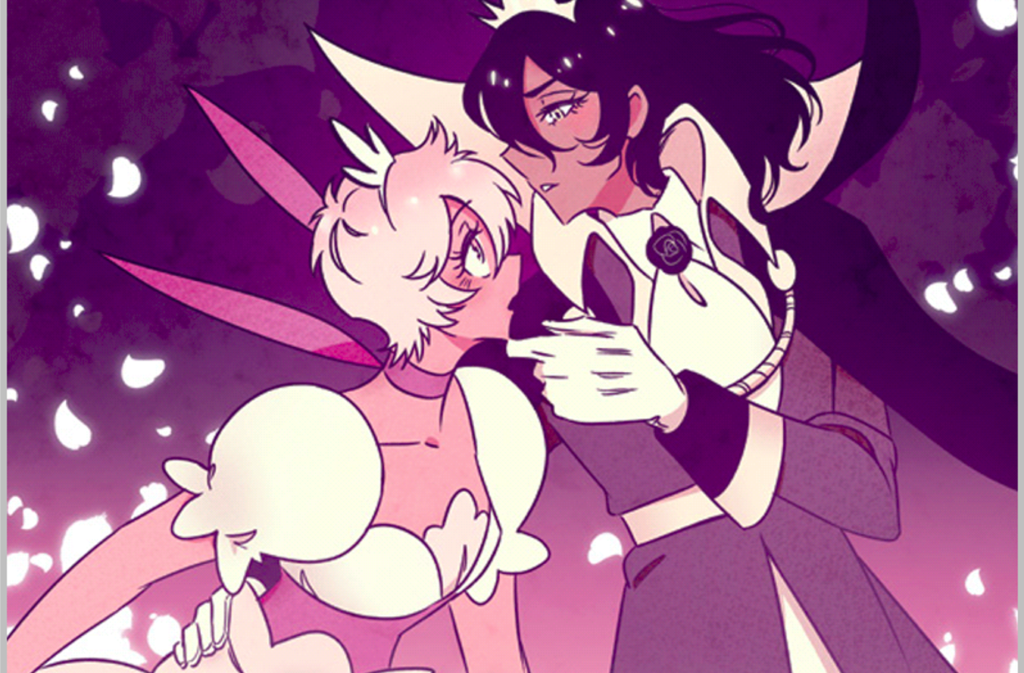Goodbye Battle Princess Peony is a beautifully queer magical girl tale
When Mira Ong Chua’s Goodbye Battle Princess Peony was first announced last year, the title gave me a strong feeling that it would be influenced by mahou shoujo anime. Mahou shoujo or magical girl anime almost always have descriptive titles such as ‘Pretty Soldier Sailor Moon‘ or ‘Revolutionary Girl Utena‘. Having finally read the digital version of the comic, I am very happy to say that my initial feeling was correct.
The black and white comic begins with the titular Peony, a battle princess on the planet of Flora, conversing with her loyal female knight Dianthus. These two discuss their ongoing battles with The Divine Ladies, their enemies on the Black Moon. However, they are suddenly interrupted by one of the Divine Ladies in question: Divine Lady Silkrose. After a brief battle, Silkrose tries to escape through a portal, but Peony grabs her cape and follows her. Not only does Peony find herself on the Black Moon, but she is also at Blackstar Academy, a school for Divine Ladies in training. In order to leave the Black Moon and Blackstar Academy, Peony must graduate by getting the approval of all four heads of class, which includes Silkrose.
First off, the initial premise is incredibly creative. Although I’ve consumed a lot of magical girl media in general, I rarely see the heroine attempt to infiltrate the antagonist’s headquarters or personal base and have to adapt to their way of thinking. Peony having to navigate her enemy’s personal base to survive is really interesting, especially once Peony gradually realizes there is more to the divine ladies than what she has been taught as a battle warrior.
Speaking of the Divine Ladies, they reminded me a lot of the flamboyant, queer-coded antagonists from Sailor Moon and Revolutionary Girl Utena. Each of them has a unique personal style and specialty as a head of the Black Star Academy. Lady Lovelace evokes an elegant, gothic lolita vibe as the head of beauty class, making chic outfits for divine ladies and ladies in training. With her ruffles blouse, cloak, and mantle, Lady Moonshine looks like somebody from a Shakespeare play, which suits her position as head of charm class.
Meanwhile, Lady Nightsky looks rather princely in her black vest, long dress shirt, and cape and mantle. As with Lovelace and Moonshine, Nightsky’s outfit enhances the charisma she has as head of power class. I also liked Lady Silkrose’s gothic suit, cape, and mantle outfit; it enhanced her mysterious nature instead of revealing anything new. This isn’t a bad thing, as this allowed me to appreciate Peony’s growing relationship with Silkrose.

Without delving into spoilers, I will say that Silkrose ends up being wonderfully multifaceted as a character and a worthy love interest for Peony. There is the saying that ‘every rose has its thorn’, but for Silkrose the opposite is especially true. The thorny black roses that are Silkrose’s trademark also represent her initial prickly personality, her mysterious and complicated past, and a softer side that is revealed as the story progresses.
In fact, Silkrose’s motif is just one of the many floral motifs that I came to appreciate in this comic book, since the motifs took a page from Utena. After noticing how Peony and Silkrose were named after actual flowers, I Googled the names of the other characters and found that they were also related to flowers. In addition, the floral motif is also represented in the beautiful artwork, especially in certain scenes. A particular favorite scene that I enjoyed is when Silkrose and Peony converse in a garden made entirely of black roses.
Not only does the artwork reinforce the themes, but it also elevates the action, dialogue, and character interactions. In particular, the high contrast art and lettering seems to take advantage of its representation of light vs darkness to increase lighter or darker tones as the story develops. For example, when Peony falls into the portal to the black moon, darkness is all around her and Peony stands out as a bright white figure. Her internal thoughts are also seen in bright white text.
When it comes to the action sequences, there are very engaging battles that combine elements from Sailor Moon and Revolutionary Girl Utena. There are magic attacks that are quite literally flowery, and there is also quite a bit of swordplay too. The emotional tension is heightened by Peony’s internal or spoken dialogue from her or other characters, or art that serve as a “close-up” to the battles.
Last but not least, there is Peony herself. Not only does she have pretty outfits, but she has wonderful character development. Starting off as a naive, well-meaning battle warrior, Peony starts off with a simplistic worldview that is summed up as, “battle warriors are good and divine ladies are evil.” Peony gradually moves away from this as the story advances and this is seen not only in her views and actions, but also in her skill as a battle warrior. Since her growth as a warrior is influenced by her growth as a person, the climax of her character arc results in a satisfying, epic payoff.

Overall, Goodbye Battle Princess Peony is a beautiful magical girl fairy tale. With striking characters, dynamic artwork, and a compelling storyline, the comic shows the flaws and allure of light and darkness.







